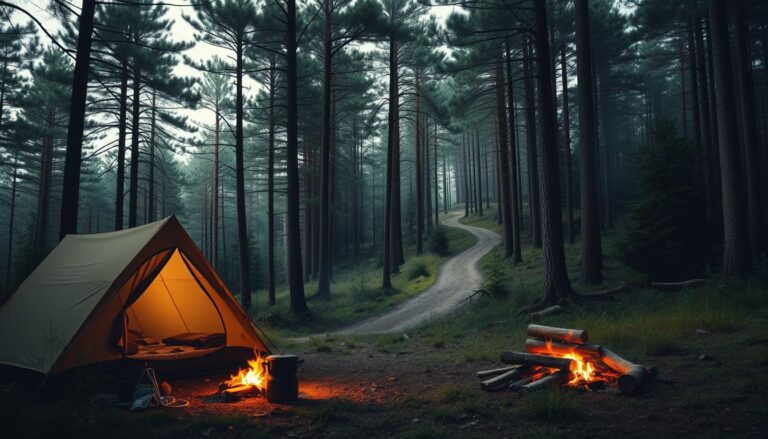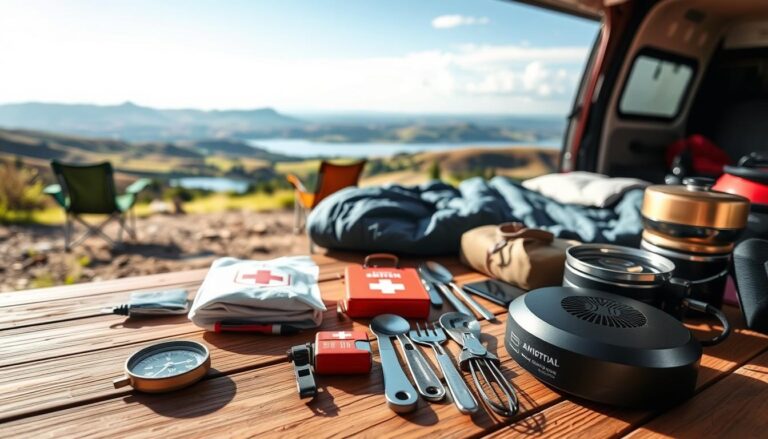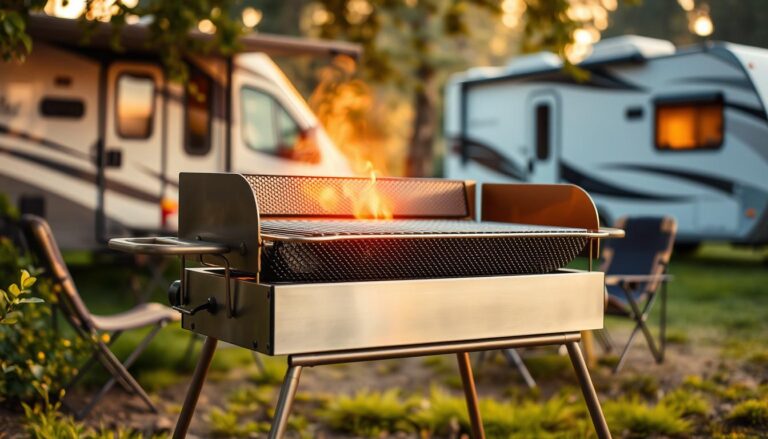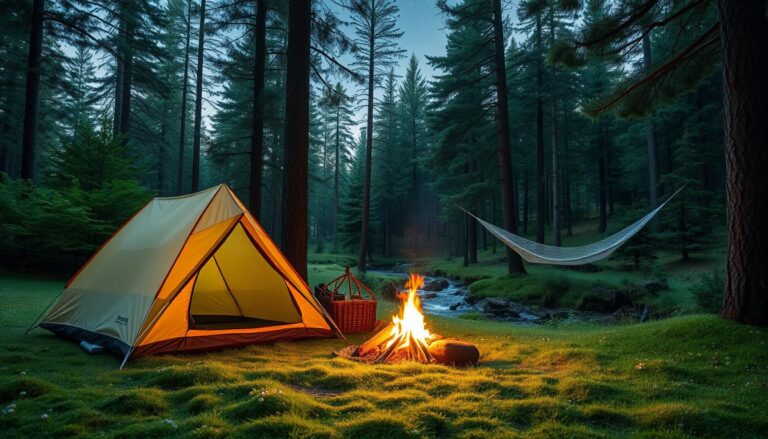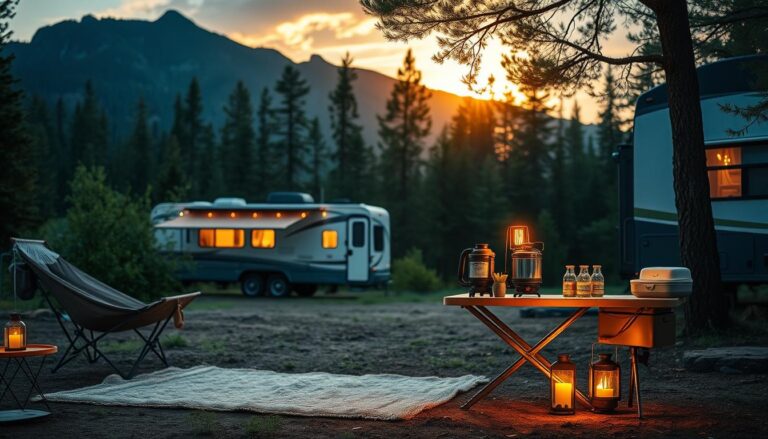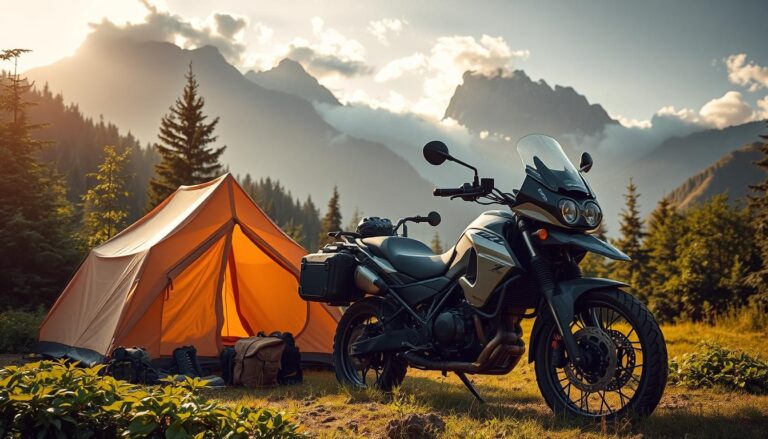Easy Meal Planning for Your Next RV Camping Adventure
RV camping lets you explore freely, but it’s the meals that make memories. Planning your meals for an RV trip makes your adventure stress-free. Imagine enjoying homemade dishes under the stars or having breakfast at your favorite trailhead. This is the joy of cooking in your own kitchen on wheels.
My RV trips taught me that smart meal prep saves money and lets you tailor meals to everyone’s tastes. Whether you’re a seasoned traveler or new to the road, learning to plan meals for an RV camping trip opens doors to flexible, flavorful meals no matter where your journey takes you.
Key Takeaways
- Meal planning cuts costs and reduces grocery store runs.
- RV kitchens let you adapt meals to dietary preferences.
- Simple recipes work best in limited RV spaces.
- Prepping ingredients before departure saves time.
- Enjoying home-cooked food enhances every camping moment.
Setting the Stage for RV Meal Planning
RV meal planning is more than just packing snacks. It’s a way of thinking. My first trip showed me that just winging it isn’t enough. Now, I plan meals to enjoy every moment on the road. Every menu I make is based on one key idea: being flexible yet intentional.
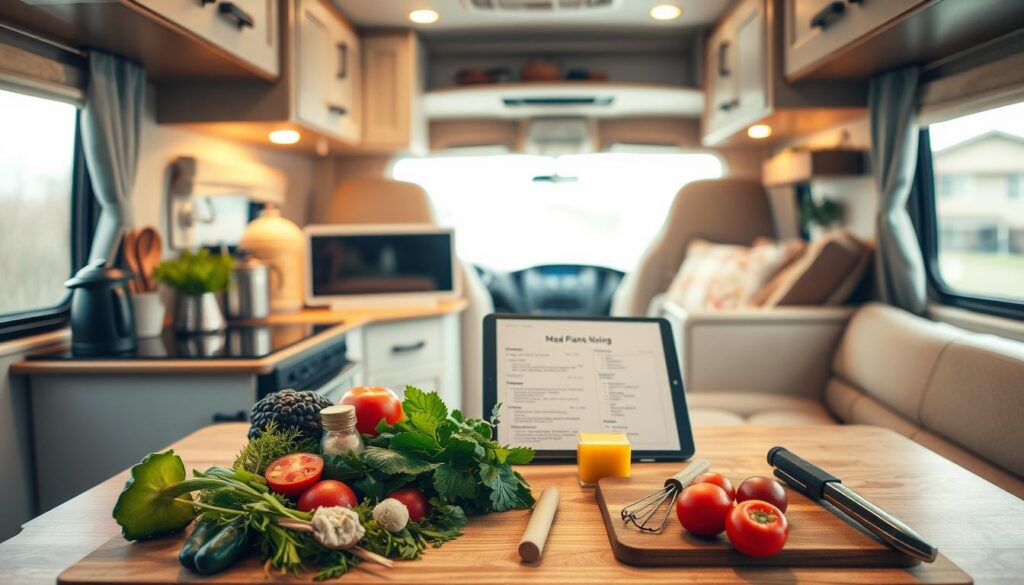
Why I Embrace RV Meal Planning
- Freedom to adapt meals to scenic stops or road delays
- Creative solutions for tiny kitchens and limited storage
- Healthier choices by avoiding fast food fatigue
My Journey to Seamless Camping Meals
My early trips were a mess. I’d forget spices or overpack perishables. Then, I learned from RVers Magazine to pack dry goods first. Now, I focus on ingredients like quinoa and canned beans.
A camper once said to me:
“A well-planned meal feels like a victory in the wilderness.”
Today, I plan meals around my favorite cast-iron skillet. I use it for dinner, breakfast, and even pancakes. Small changes have made my trips calm and enjoyable. Every menu I create brings me closer to loving the journey, not just surviving it.
Essential RV Kitchen Essentials
Choosing the right rv kitchen essentials is key for a successful trip. My collection includes items that are both functional and space-saving. A 3-quart Instant Pot can make everything from oatmeal to chili. A collapsible silicone spatula also saves space in your drawers.
Cast iron skillets from Lodge Outdoors are great for searing or baking campfire pies. They’re perfect for cooking outdoors.
“Less is more when packing—prioritize tools that multitask.” – Camping Pro Tips
- Portable gas burner: Adds stovetop flexibility for boiling or frying
- Compact manual can opener: Must-have for shelf-stable meals
- Insulated food containers: Keep leftovers warm without electricity
- Camp Chef folding griddle: Doubles as pancake maker and burger press
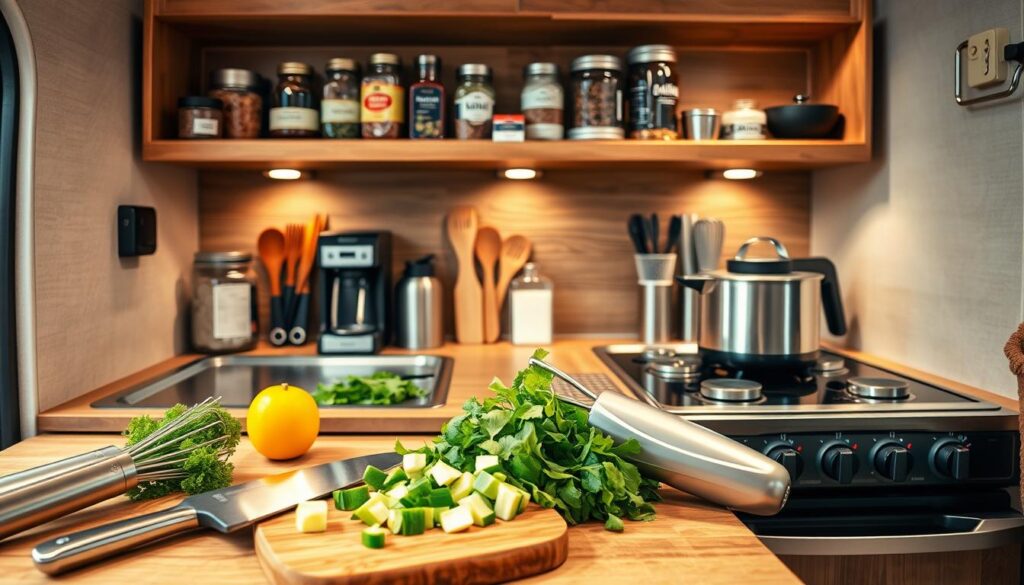
Space-saving gadgets like a magnetic knife strip free up counter space. My favorite is the Kamen magnetic system, which sticks to the RV’s stainless steel. Don’t forget silicone collapsible bowls—they stack flat when empty.
Every item in my setup has multiple uses. For example, a coffee press can also be a salad spinner. Silicone baking mats eliminate the need for parchment paper. These smart choices make every inch of the tiny kitchen count.
Plan Meals for an RV Camping Trip
Creating a meal plan for RV trips is all about being creative and practical. My top camping menu ideas are simple yet flexible. They make sure you always have a plan, no matter what.
Creating a Flexible Meal Schedule
RV trips need schedules that can change easily. I start with a basic daily plan:
- Plan 1-2 main meals daily to save time
- Have 1 “no-cook” option like salads or wraps for when things get busy
- Use a dry erase board to change meals as needed
Prioritizing Nutrient-Dense Foods
Healthy food doesn’t have to be hard to make. Choose ingredients that give you energy for your adventures:
| Food Group | Top Picks |
|---|---|
| Proteins | Canned chickpeas, jerky, hard-boiled eggs |
| Grains | Rice, couscous, instant potatoes |
| Snacks | Nut butter packets, trail mix, dried fruit |
These foods are great for any campsite, whether you’re hiking or relaxing. Mixing flexibility with nutrition makes mealtime a fun part of your trip, not a hassle.
Creative and Easy RV Camping Recipes
RV cooking doesn’t have to be hard. My top easy rv camping recipes are simple and flexible. You can grill, use a portable stove, or pack no-cook meals. These ideas are creative and delicious.
| Recipe | Prep Time | Ingredients | Tips |
|---|---|---|---|
| One-Pot Pasta Primavera | 15 mins | Pasta, frozen veggies, jarred sauce, olive oil | Pre-cook pasta, add veggies, and stir in sauce for a quick meal. |
| Breakfast Burrito Bake | 10 mins (plus chilling) | Tortillas, eggs, cheese, salsa, black beans | Layer ingredients in a disposable pan; bake en route. |
| Vegetarian Quinoa Salad | 20 mins | Quinoa, canned chickpeas, dried fruit, nuts, lemon juice | Prep at home; store in airtight containers. |
These easy rv camping recipes use easy-to-carry ingredients and little cleanup. I mix pre-chopped veggies with pantry items like canned beans and rice. For different diets, change proteins or spices. My secret? Make double batches of sauces or marinades to save time.
Trying new flavors keeps meals fun. Add smoked paprika to rice or mix yogurt with herbs for a tasty dip. The goal is to enjoy every bite, not just get by.
RV Cooking Tips for a Successful Trip
Maximizing space and creativity is key to enjoyable campsite meals. These rv cooking tips turn challenges into opportunities for innovation. Let’s explore smart strategies for thriving in small kitchens.
Mastering Limited Space Cooking
Every inch counts in an RV. Here’s how I optimize my setup:
- Mount magnetic spice racks and utensil holders on walls to free counters.
- Use stackable storage containers for dry goods and pantry staples.
- Invest in a portable electric griddle—perfect for pancakes, eggs, or stir-fries.
Using Versatile Ingredients
Smart ingredient choices simplify meal prep. Below are top picks that shine in any dish:
| Ingredient | Uses | Benefits |
|---|---|---|
| Steel-cut oats | Bowls, overnight oats, granola | Non-perishable, high fiber |
| Chicken broth | Soups, rice dishes, sauces | Extends shelf life of meals |
| Whole grain pasta | Pasta salads, baked dishes, stir-fries | Lightweight and filling |
These strategies transform cramped spaces into functional kitchens. With practice, rv cooking tips become second nature—making every meal a chance to savor the journey.
Meal Prep Strategies for Stress-Free Campsite Cooking
Starting with smart planning is key for meal prep for camping. I found out that prepping ingredients before leaving makes things easier. Here’s how I do it:
- Pre-chop veggies and store them in airtight containers. This keeps carrots and bell peppers fresh.
- Marinate proteins the night before to save time at the campsite. I use glass jars to avoid plastic smells.
- Batch-cook grains like quinoa or rice. Freeze them in labeled containers for quick reheating.
| Storage Method | Best For | Tip |
|---|---|---|
| Airtight containers | Meat & veggies | Freeze liquids first to save space |
| Ziploc bags | Soup bases or sauces | Squeeze out air before freezing |
| Reusable silicone bags | Snacks & salads | Wash once back home |
I always carry a meal prep for camping toolkit. It includes a portable cutting board and sharp knife. I also pack dressings in small jars for easy access. My top tip? Assemble tacos or wraps before you go. Just warm the tortillas and toppings at the campsite.
Time-Saving Make-Ahead Meals for RV Camping
Planning ahead makes RV trips stress-free. My secret? Batch-cooking and smart storage. Here’s how I do it:
Begin by prepping meals like chili, soups, and grain bowls. Freeze them in airtight containers. My top tip? Use single-serving bags for meals. They thaw fast and save space.
- Freeze cooked proteins (chicken, beans) for quick breakfast scrambles
- Assemble casserole components in disposable aluminum pans for easy cleanup
- Prep snacks like veggie sticks and trail mixes in mason jars
| Meal Prep Idea | Storage Solution |
|---|---|
| Vegetable stir-fry kits | Layer veggies in ziplock bags with soy sauce packets |
| Cooked grains (quinoa, rice) | Seal in glass containers in the fridge |
| Breakfast burritos | Stack in the freezer, labeled by meal type |
“Space is your ally, not your limit.” — RV Meal Prep Pro Tips
On the road, I organize my fridge using the “first in, first out” rule. Keep perishables like cheese and fresh veggies in the front. Use the freezer for frozen meals. Always check internal temps with a digital thermometer.
My secret? Label everything clearly with dry-erase markers. It saves prep time and keeps meals fresh. With these tips, every meal is a joy, not a chore.
Choosing the Best Foods for RV Trips
When packing for an RV trip, picking the best foods for rv trip is key. You need to balance taste, nutrition, and how easy they are to pack. I choose ingredients that stay fresh and don’t take up too much space.
Durable veggies like carrots and bell peppers are great. They go well with non-perishables like canned beans or whole-grain pasta.
- Opt for vacuum-sealed meats and shelf-stable dairy alternatives.
- Pack dried fruits and nuts for energy-boosting snacks.
- Use airtight containers to keep grains and spices organized.
Local farmers’ markets are a treasure. They offer fresh produce like seasonal berries or leafy greens. This adds variety without losing quality. I always ask vendors for tips on keeping food fresh.
Pro tip: pre-chop veggies at home to save time on-site.
“The key to great RV meals is marrying convenience with flavor.”
Proteins are important too. I use marinated tofu or canned salmon for quick protein. For longer trips, vacuum-packed chicken breasts stay fresh in a cooler with ice packs.
Don’t forget pantry staples like quinoa, lentils, and instant oats. They fuel adventures without hassle.
Smart storage is essential. My fridge/freezer setup keeps dairy and greens crisp. A dry goods bin holds spices and pasta. Planning this way lets me enjoy hearty meals like black bean tacos or veggie stir-fries anywhere the road leads.
A Guide to RV Meal Planning and Organization
Planning meals on the road can be a challenge. But, with the right strategies, it becomes easier. Here’s how to save money and follow nature’s rhythms:
Budget-Friendly Tips
- Buy bulk staples like rice, beans, and spices from warehouse clubs like Costco or Sam’s Club.
- Use store-brand pantry items—my go-to for pasta and canned tomatoes cuts costs by 30%.
- Prep freezer meals like chili or soups before departure. A 2-quart mason jar holds enough for two meals.
“Smart planning turns $10 into three days of food,” says outdoor chef Sarah Thompson in her Camping on a Dime guide.
Seasonal Menu Adjustments
Adjust ingredients based on travel seasons:
- Winter: Swap fresh salads for hearty soups using frozen veggies.
- Summer: Pack reusable containers for picnic salads and grilled skewers.
- Autumn: Stock up on apples and root vegetables at farmers markets.
I always check local produce stands for deals—last fall I saved $25 buying bulk squash.
By combining these strategies, my last 7-day trip cost under $50 per person. The secret? Flexibility and foresight. Let nature’s bounty and smart shopping make every trip a feast without breaking the bank.
Conclusion
RV meal planning is more than just packing snacks. It turns every trip into a food adventure. Over the years, I’ve found that a tidy kitchen and flexible meal plans are key. Preparing meals ahead, using space-saving containers, and picking versatile foods like quinoa make every campsite a kitchen.
The right tools, like a portable stove or a lightweight skillet, make small RV kitchens work well. Nutrient-rich foods keep energy up for hikes. Simple recipes let me enjoy meals without stress.
Begin with the basics. Stock your pantry with essentials, plan a few favorite dishes, and test your setup before you go. At first, I was worried about space and time. But now, I love adapting meals to fit each trip’s mood.
Whether it’s a quick breakfast burrito or a slow-cooked chili, every meal is part of the journey. Meal prep shouldn’t scare you. Start with these tips and see how planning changes trips into unforgettable memories. The open road is waiting, and with the right meals, every place tastes better.
Pack your pots, plan your meals, and get ready for adventure. Your stomach and spirit will thank you.

